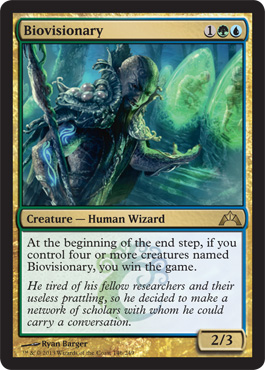Last week I wanted to give my friend Patrick Sullivan’s RDW strategy in Legacy a whirl. I made my deck with main-deck Searing Blaze, as Patrick had suggested when I hung out with him in Las Vegas recently.
Testing was brief and miserable.
It wasn’t Patrick’s fault.
I was playing two-man Legacy queues on MTGO and — as is sometimes the case in the wee hours — you keep trying to get reps in on a two-man queue, and you just end up playing the same guy over and over. In this case, the guy was playing a Show and Tell / Omniscience deck. He got very fast draws and beat me badly a couple of times. I made a mental note that if I were to try Patrick’s deck in a real / big Legacy tournament (like the upcoming Star City Invitational in NJ in a couple of months) I would play Red Elemental Blast or thereabouts. I didn’t like having no access to meaningful interaction.
The first time we fought I sided in Ensnaring Bridge. I even drew one for his turn two or turn three Show and Tell! The opponent had beaten me in Game One with Emrakul, the Aeons Torn. I decided that even if he was “legitimately” casting Emrakul (i.e. getting the free Time Walk) that I could keep him from actually attacking me.
Unfortunately instead of Emrakul, he dropped Omniscience; his next play — upon seeing my Ensnaring Bridge — was to play a free Burning Wish. He found the seldom-seen Petals of Insight and drew through his deck until he could find a non-attacking way to win. He ended up just racking up tons of reps with his Petals of Insight (all free, thanks to Omniscience), found another Burning Wish, played it (for free) and got a Grapeshot (again for free, and more than big enough to kill me).
Like I said, I dropped out of the Legacy queues and eventually worked on my Liliana of the Dark Realms deck, which turned out brilliantly, as you know. I stopped playing Legacy RDW (at least for a little while) but really admired the ingenuity of including a card like Petals of Insight, really taking advantage of the radically altered game state afforded by an on-line Omniscience.
Luckily, this is a reality limited to big formats.
Or is it?
Enter, ahem, Enter the Infinite:

Enter the Infinite
Travis Woo has recently returned to the forefront of rogue deck design with his OmniDoor deck. A Standard Omniscience deck, Travis’s plays Omniscience and then sets up a couple of copies of Temporal Mastery. It can win all different ways including getting in multiple shots from Nicol Bolas, Planeswalker (with two extra turns it isn’t hard to get Bolas Ultimate) or just attacking you with a Thragtusk powered up by Kessig Wolf Run.
With Enter the Infinite, once you have Omniscience down, you can just draw your deck and win with whatever you want to win with. You kind of really do need Omniscience first, because even if you can cast Enter the Infinite to draw your deck, that doesn’t mean you can cast everything. “All your cards” doesn’t equal “all necessary mana” … But when you have Omniscience down that’s not a problem.
My current favorite way to close out an “infinite” game is by getting all the copies of another new card, Biovisionary:

Biovisionary
Obviously you can just get all four and put them into play; or you can get all four, Clone and Evil Twin them, and then pass. Interacting with you at this point is probably pointless, because you can have a Counterspell (and the “mana” to use it). You probably have access to more good answers in hand (and can cast them) than the opponent has spells, total.
BDM mentioned tonight you can get circa one Laboratory Maniac [as well] and win with card draw if something happens to your Biovisionaries.
But hey!
Just spitballing.
Not much else matters when you Enter the Infinite, after all.
LOVE
MIKE
1 comment so far ↓
Gatecrash: Nothing Else Matters When You ENTER THE INFINITE…
Your story has been summoned to the battlefield – Trackback from MTGBattlefield…
You must log in to post a comment.